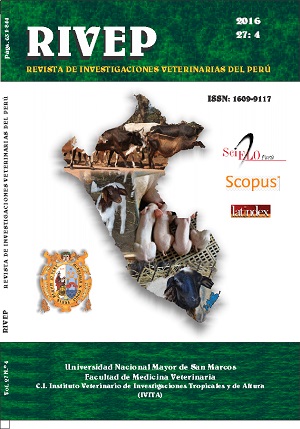Gastrointestinal helminth fauna of zoonotic importance and pathological aspects in rodents (Rattus spp) in three environments
DOI:
https://doi.org/10.15381/rivep.v27i4.12568Keywords:
Rattus rattus, Rattus norvegicus, zoonoses, zoo, pig farms, marketsAbstract
The study aimed to identify and determine the prevalence of zoonotic gastrointestinal helminths present in rodents (Rattus spp) in three environments (pig farms, zoo and food markets) of Lima, Peru and estimate the association between the presence of helminths and the variables place of origin, species, age and sex. A total of 245 rodents (Rattus rattus and Rattus norvergicus) were captured alive using live trap cages and were subsequently euthanized. Skulls, skin, teeth and morphometric parameters were used for taxonomic classification of species. Stomach and small and large intestine were collected. The helminths found were placed in 70% alcohol and selected tissues were preserved in 10% formalin. The prevalence of gastrointestinal helminths in rats was 72.2% whereas the prevalence of zoonotic helminth was 46.5%. Four species of zoonotic importance were found: Raillietina demerariensis, Gongylonema neoplasticum, Hymenolepis diminuta and Moniliformis moniliformis, where the latter two were more frequent in the three ecosystems. Other helminths identified were Mastophorus muris, Heterakis spumosa, Aspicularis tetrapera, Syphacia muris, Trichuris muris, Capillaria sp and Vampirolepis fraterna. The histopathological findings included a decrease in size of the villi, detachment of epithelial cells, increased numbers of goblet cells and enterocytes with eosinophils, lymphocytes, plasma cells and macrophages associated with H. diminuta, M. moniliformis and R. demerariensis.Downloads
Downloads
Published
Issue
Section
License
Copyright (c) 2017 Deisy Abad A., Amanda Chávez V., Rosa Pinedo V., Manuel Tantaleán V., Omar Gonzáles-Viera

This work is licensed under a Creative Commons Attribution-NonCommercial-ShareAlike 4.0 International License.
AUTHORS RETAIN THEIR RIGHTS:
a. Authors retain their trade mark rights and patent, and also on any process or procedure described in the article.
b. Authors retain their right to share, copy, distribute, perform and publicly communicate their article (eg, to place their article in an institutional repository or publish it in a book), with an acknowledgment of its initial publication in the Revista de Investigaciones Veterinarias del Perú (RIVEP).
c. Authors retain theirs right to make a subsequent publication of their work, to use the article or any part thereof (eg a compilation of his papers, lecture notes, thesis, or a book), always indicating the source of publication (the originator of the work, journal, volume, number and date).










